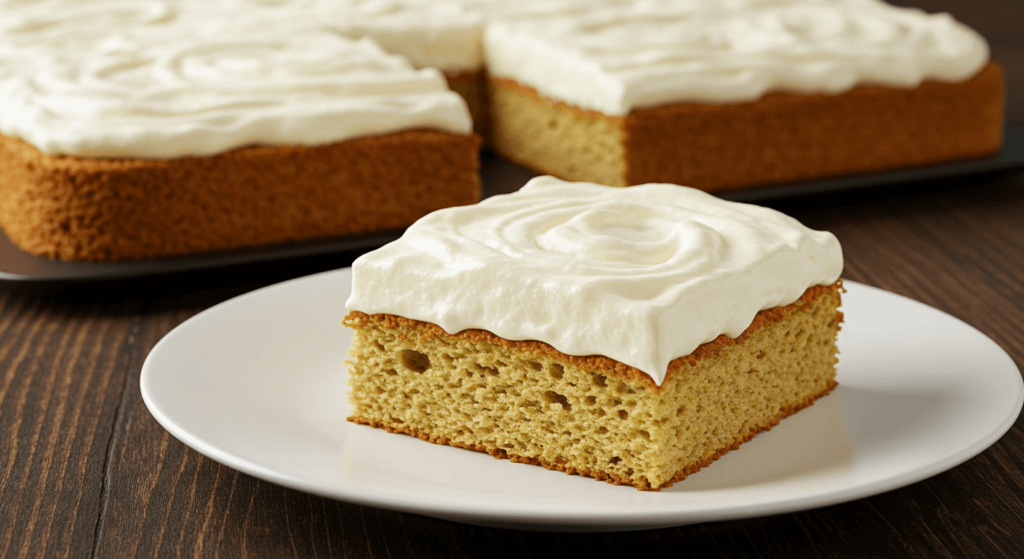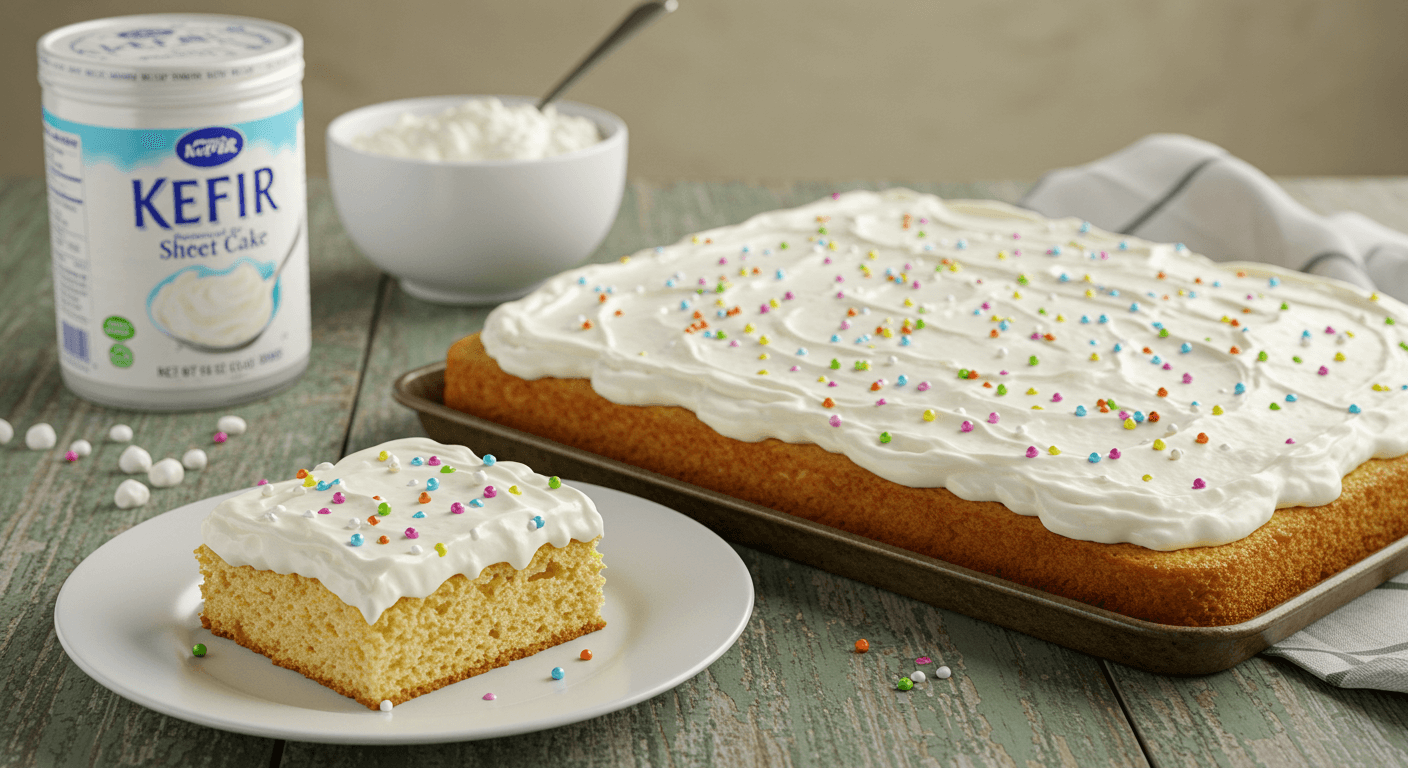Have you ever tasted a cake so moist, so fluffy, that it instantly became your favorite? If you’ve ever tried kefir sheet cake, you know exactly what I’m talking about. But if you haven’t, you’re in for a treat. The magic ingredient here is kefir-a tangy, probiotic-rich drink that transforms your average cake into something extraordinary. If you’ve been curious about kefir sheet cake and what makes it so special, you’re in the right place. In this article, we’ll dive into every ingredient that goes into making this mouthwatering cake and explain how they each contribute to its unforgettable flavor and texture.
Table of Contents
What is Kefir Sheet Cake?
Kefir sheet cake is a unique variation of traditional sheet cake, with kefir being the star ingredient. Kefir is a fermented dairy product that adds a tangy, slightly sour flavor to the cake, making it incredibly moist and rich in probiotics. Not only does kefir elevate the flavor, but it also contributes to the cake’s soft, tender texture. It’s a cake that’s simple to make but has a surprising depth of flavor that will have everyone asking for seconds.

The Essential Ingredients for Kefir Sheet Cake
Kefir – The Star Ingredient
The most important ingredient in kefir sheet cake is, of course, kefir itself. But what exactly is kefir, and why should you use it in your baking?
Kefir is a fermented dairy drink, similar to yogurt but with a thinner texture. It’s made by adding kefir grains to milk, allowing the bacteria and yeast to ferment the milk, creating a tangy, creamy drink. This fermented goodness is packed with probiotics that are beneficial for gut health. When incorporated into cakes, kefir adds a rich moisture and a subtle tang that elevates the flavor profile.
Health Benefits of Kefir:
- Probiotics: Kefir is loaded with probiotics that promote healthy digestion.
- Rich in Nutrients: Kefir contains calcium, protein, and vitamins, offering a nutritional boost to your dessert.
- Supports Immune Health: The probiotics in kefir can help boost your immune system, making your treat not just delicious but beneficial.
In baking, kefir not only brings these benefits but also acts as a natural tenderizer, helping the cake stay moist even after a few days. You’ll find that using kefir results in a cake that doesn’t dry out as quickly as cakes made with regular milk or buttermilk.
Flour – The Base of the Cake
Flour is a key ingredient in any cake, and kefir sheet cake is no different. The type of flour you choose can greatly affect the texture of the cake, so it’s important to use the right one.
What Type of Flour Should You Use?
For the best results, all-purpose flour is the go-to for kefir sheet cake. It provides a light texture and allows the kefir to shine through without overwhelming the cake’s structure. If you’re looking for a denser, heartier option, you can experiment with whole wheat flour. However, note that this will change the flavor and texture, giving the cake a slightly nuttier taste and denser consistency.
Why Flour Matters
Flour acts as the foundation of the cake. It helps give the cake structure and holds all the other ingredients together. The amount of flour used also affects how fluffy or dense the cake will be. When combined with kefir, flour works to create a perfect balance, ensuring that the cake rises properly while maintaining a soft, tender crumb.
Eggs – Binding and Structure
Eggs play a crucial role in baking, and kefir sheet cake is no exception. They help bind the ingredients together, creating the structure and texture you expect from a cake. Without eggs, your cake might fall apart, and the texture could be rubbery.
How Eggs Help Your Cake
Eggs contribute to the cake’s rise by trapping air bubbles during mixing. These bubbles expand in the oven, helping the cake puff up and become light and fluffy. They also provide moisture and richness, making the cake taste indulgent.
If you’re following a vegan diet or have an egg allergy, you can easily replace eggs in this recipe. A common substitute is flaxseed meal mixed with water or chia seeds, which mimic the binding and moisture-retaining properties of eggs.
Sugar – Sweetness with Balance
Sugar is essential for any dessert, and it plays a significant role in kefir sheet cake.It not only adds sweetness to the cake but also improves its texture and promotes browning. The right amount of sugar ensures that the tanginess of the kefir doesn’t overpower the cake’s flavor.
Types of Sugar to Use
Granulated sugar is typically used in kefir sheet cake, as it provides the perfect balance of sweetness and texture. If you’re looking for a deeper, more caramelized flavor, you can substitute granulated sugar with brown sugar or even honey. Brown sugar adds moisture and gives the cake a slightly richer taste. Honey will contribute its own unique sweetness and a slight floral note.
How to Balance Sweetness
When using kefir, it’s important to balance the tangy flavor with just the right amount of sweetness. Too much sugar, and the cake will be overly sweet, masking the delicate kefir flavor. Too little sugar, and the tanginess of the kefir might be too sharp. Finding the perfect balance is key.
Baking Powder & Baking Soda – Leavening Power
Baking powder and baking soda are the leavening agents in kefir sheet cake that help it rise. These ingredients create bubbles of carbon dioxide in the batter, which expand when heated, causing the cake to rise and become light and fluffy.
What’s the Difference Between Baking Soda and Baking Powder ?
- Baking Soda: This leavening agent requires an acidic ingredient (like kefir) to activate it and create lift. It also helps with browning the cake.
- Baking Powder: Unlike baking soda, baking powder contains both an acid and a base, so it doesn’t need additional acidity to work. It helps provide extra lift and ensures the cake rises evenly.
Both ingredients are necessary for the perfect rise and texture, but you can’t substitute one for the other without affecting the final result.
Butter or Oil – Adding Moisture
Butter and oil are both used in cakes to add moisture and richness. In kefir sheet cake, the choice between butter or oil can change the texture and flavor of your dessert.
Butter for Rich Flavor
Butter gives the cake a rich, flavorful taste and a slightly denser crumb. It’s the go-to option if you want a cake that feels luxurious and indulgent.
Oil for Moisture
Oil, on the other hand, creates a lighter, moister texture. It helps the cake stay soft longer and makes it more forgiving if you accidentally overbake it. Canola or vegetable oil works well, as these neutral oils don’t overpower the flavor.
You can choose either butter or oil based on your preference. Some bakers even use a combination of both for the best of both worlds.
How to Combine Kefir Sheet Cake Ingredients
Now that you’ve learned about the essential ingredients, it’s time to put them together. The order in which you mix your ingredients can make a big difference in the texture of your cake.
Start with Wet Ingredients
Begin by whisking together your kefir, eggs, and melted butter (or oil) in a large bowl. The wet ingredients need to be well-blended before adding the dry ingredients.
Sift the Dry Ingredients
Sifting your dry ingredients—flour, baking powder, and baking soda—ensures that they are evenly distributed. This also prevents lumps and ensures a smooth batter.
Fold, Don’t Stir
When combining the wet and dry ingredients, it’s important to fold them together gently. Overmixing the batter can make the cake dense and tough.
Folding helps maintain the air bubbles, resulting in a light, fluffy texture.
Recipe Table: Kefir Sheet Cake Ingredients
| Ingredient | Amount | Purpose |
|---|---|---|
| Kefir | 1 cup | Adds moisture and tang, helps tenderize the cake. |
| All-purpose Flour | 1 ½ cups | Forms the structure of the cake. |
| Eggs | 2 large | Bind ingredients and add texture. |
| Granulated Sugar | 1 cup | Provides sweetness and balances tangy kefir. |
| Baking Powder | 1 tsp | Helps the cake rise. |
| Baking Soda | ½ tsp | Assists with leavening and helps with texture. |
| Butter (or Oil) | ½ cup | Adds moisture and flavor. |
FAQ – Kefir Sheet Cake Ingredients Explained
Can I Use Low-Fat Kefir for This Recipe?
Yes, you can use low-fat kefir, but keep in mind that the cake may be slightly less rich. Full-fat kefir adds a creamier texture and more flavor.
Can I Substitute the Eggs?
For egg-free versions, try flaxseed or chia seeds mixed with water to replicate the binding properties of eggs.
What’s the Best Type of Flour for Kefir Sheet Cake?
All-purpose flour is ideal for a light and fluffy cake. However, if you prefer a denser texture, you can use whole wheat flour.
How Do I Make a Gluten-Free Kefir Sheet Cake?
To make a gluten-free version, swap out the regular flour for a gluten-free flour blend. You might need to adjust the liquid content or baking time.
Conclusion: Create the Perfect Kefir Sheet Cake
Kefir sheet cake is more than just a dessert—it’s a flavorful, moist treat that’s easy to make and full of health benefits. By understanding the role of each ingredient, you can craft a cake that’s perfectly balanced and full of flavor. Whether you’re baking for a special occasion or simply indulging in a sweet craving, kefir sheet cake is the perfect choice. So, grab your ingredients and get baking—your taste buds will thank you!
Ready to bake? Share your kefir sheet cake creation with us and let us know how it turned out!


